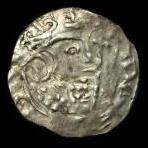








Designed by Nigel G Wilcox






The Paragon Of Metal Detecting
Powered By Sispro1
British Sterling Currency - Numismatics,
Penny
For Reference ONLY
Everything For The Detectorist
David I 1124-1153 AD
Royal Monarchy
Copyright © All Rights Reserved by Nigel G Wilcox · · E-Mail: ngwilcox100@gmail.com
Penny
INFORMATION - DATA
Pages
We do NOT buy or sell coins


In David's name, Edinburgh, rev. DER.IND [ON EDO]NI, 1.27g, Hammered Silver,
Scottish & Irish, Period Norman
Estimated Value £5,750
Scottish & Irish, Period Norman
Estimated Value £5,750

David I
David was sent to England to join his sisters, Edith and Mary, when he was nine years old. His sister Edith was to become Queen of England through her marriage to King Henry I, while Mary was to marry Eustace of Boulogne and became the mother of King Stephen's Queen, Matilda of Boulogne.
David spent over thirty years of his life in England, he was married to a Norman heiress Maud of Huntingdon, daughter of Waltheof, Earl of Northampton and in her right became Earl of Huntingdon, the marriage produced two sons, Malcolm and Henry.
On the death of his elder brother King Edgar, David was given the title Earl of Cumberland and made virtual ruler of southern Scotland. He succeeded as King of Scots in 1124 on the death of his brother Alexander I.
David was destined to become the most remarkable and memorable of the sons of Malcom Canmore. On returning to his kingdom, the new King distributed estates amongst his Norman associates, the families of de Bruce, de Comines, de Balliol and Fitz Alan (who were to be the ancestors of the Stewart dynasty) He established a new French speaking Anglo-Norman aristocracy, who were eventually to intermarry with the old Celtic nobility.
Following the example set by his saintly mother, the pious David founded many new bishoprics and abbeys including Melrose, Kelso and Jedburgh and endowed many of the monasteries.
England at this time was rent by civil war as Stephen, the nephew of Henry I and Henry's daughter Matilda, who was also David's niece, faced each other in a bloody and bitter struggle for the throne. In 1135, the King of Scots decided to support his niece, which provided him with an excuse to invade England. The Scots were defeated at the The Battle of The Standard, near Northallerton, in 1138. David joined Matilda in London in 1151 and accompanied her to Winchester, where he was almost captured by Stephen's forces. As a result of the negotiations which followed, Stephen recognised Scotland's independence and ceded the greater part of Northumbria to David. He later knighted Matilda's sixteen year old son, the future Henry II, first of the Plantagenets.
King David I died on 24th May, 1153 at Carlisle and was buried at Dunfermline Abbey. He could fairly be described as one of the ablest of his dynasty. Since his only son, Henry, Earl of Northumberland had predeceased him, David was succeeded by his grandson, Malcolm IV.
* The coin, (in a field in found in County Durham) would have been struck some time after the Scots invaded England in 1136 to intervene on the side of Matilda in her war against Stephen to decide who should succeed to the English throne. The invaders captured Carlisle and its mint where the first ever Scottish coins were struck in the name of David I. Although such coins have been found before, the one discovered is a previously unknown transitional type combining an early obverse (front) with a later reverse. It is unique and so of interest to museums and historians as well as collectors.
David spent over thirty years of his life in England, he was married to a Norman heiress Maud of Huntingdon, daughter of Waltheof, Earl of Northampton and in her right became Earl of Huntingdon, the marriage produced two sons, Malcolm and Henry.
On the death of his elder brother King Edgar, David was given the title Earl of Cumberland and made virtual ruler of southern Scotland. He succeeded as King of Scots in 1124 on the death of his brother Alexander I.
David was destined to become the most remarkable and memorable of the sons of Malcom Canmore. On returning to his kingdom, the new King distributed estates amongst his Norman associates, the families of de Bruce, de Comines, de Balliol and Fitz Alan (who were to be the ancestors of the Stewart dynasty) He established a new French speaking Anglo-Norman aristocracy, who were eventually to intermarry with the old Celtic nobility.
Following the example set by his saintly mother, the pious David founded many new bishoprics and abbeys including Melrose, Kelso and Jedburgh and endowed many of the monasteries.
England at this time was rent by civil war as Stephen, the nephew of Henry I and Henry's daughter Matilda, who was also David's niece, faced each other in a bloody and bitter struggle for the throne. In 1135, the King of Scots decided to support his niece, which provided him with an excuse to invade England. The Scots were defeated at the The Battle of The Standard, near Northallerton, in 1138. David joined Matilda in London in 1151 and accompanied her to Winchester, where he was almost captured by Stephen's forces. As a result of the negotiations which followed, Stephen recognised Scotland's independence and ceded the greater part of Northumbria to David. He later knighted Matilda's sixteen year old son, the future Henry II, first of the Plantagenets.
King David I died on 24th May, 1153 at Carlisle and was buried at Dunfermline Abbey. He could fairly be described as one of the ablest of his dynasty. Since his only son, Henry, Earl of Northumberland had predeceased him, David was succeeded by his grandson, Malcolm IV.
* The coin, (in a field in found in County Durham) would have been struck some time after the Scots invaded England in 1136 to intervene on the side of Matilda in her war against Stephen to decide who should succeed to the English throne. The invaders captured Carlisle and its mint where the first ever Scottish coins were struck in the name of David I. Although such coins have been found before, the one discovered is a previously unknown transitional type combining an early obverse (front) with a later reverse. It is unique and so of interest to museums and historians as well as collectors.

Estimated between £8,000 - 12, 000
*
6. S. Menu
Main Coin Menu

VIEW ALL MENUS
Member NCMD
























